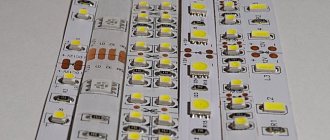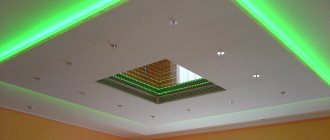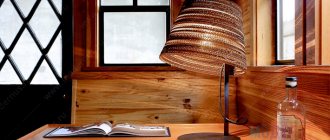Selection of material and wire cross-section
In order to install wiring, you need to know what wires to buy and what size they should be. On the modern market of building materials and electrical equipment you can find a great variety of products from various brands. But for us it will be enough to know the two main types that the market represents - these are VVG and PVS. VVG is bare vinyl, that is, each core was in vinyl insulation, and all these cores were in another insulation. Usually, in construction stores, such a cable is only single-core, that is, its core is cast, and not made of hundreds of thin wires.
PVA is a vinyl insulated connecting wire. The most common copper wire, which is used both for wiring and for making carriers and other devices. This cable is made of copper and has stranded wires, that is, one core consists of hundreds of thin wires, this has a positive effect on its electrical conductivity and, in general, on the quality of the product.
If you are going to partially make the wiring, then you should find out what wires you already have installed. If the copper is single-core, choose VVG, if it is aluminum noodles, then choose AVVG - the same VVG, only aluminum. If you have completely decided to change the wiring, then definitely opt for the PVS cable.
Select a section. Typically, modern wiring is made separately for the lighting group and for the group of sockets, and for particularly powerful consumers, a separate line is drawn from the panel. So, the line for lighting is carried out using a 1.5 mm² wire, and it will be enough to lay the socket line with a 2.5 mm² wire. By the way, these values correspond to the PUE.
If you want to individually calculate the cross-section of the conductors, then calculate the entire load on the line. For example, we run a separate line to the kitchen. There we have a washing machine (1.5 kW), an electric kettle (2 kW), a microwave oven (1.5 kW), and small kitchen appliances such as a mixer and blender (1 kW). We add everything together and we get that when used simultaneously, the power consumption will be 6 kW/h. 6000/220=27 amperes is the current consumed by your appliances.
A 2.5 mm² wire passes exactly 27A, a 1.5 mm² cable passes a current of 4.1A. If you have more powerful equipment, for example, an electric stove, then take a more powerful cable - 4 mm², which is capable of passing a current of 38A. If you are planning LED lighting, then select 1 mm² per lighting group. It is not worth taking less, since cases of installing conventional tungsten lamps are not excluded. Based on these figures, we calculate the cross-section of our conductors.
Electrical wiring diagram above a suspended ceiling for spotlights
Typically, there are two schemes for switching on spotlights and, accordingly, two types of wiring - parallel and star. A parallel wiring diagram above a suspended ceiling is also called a loop and provides for parallel joining of all lamps, with conductor connections in the lamp itself or next to it.
The “star” circuit is a connection of conductors at one point, and the installation to each lamp is carried out with a separate cable.
The choice of wiring diagram should, in theory, be based on the convenience of wiring and maintenance of the entire circuit. But when working with spotlights, there is a peculiarity - different operating voltages of future lamps - 12 V or 220 V. As you know, according to Ohm’s law, with the same power, voltage and current are inversely proportional. In simple terms, a small current and a large voltage in one case, or a large current and a small voltage in another.
Choosing a wire for electrical wiring above a suspended ceiling
Before buying a cable for electrical wiring behind a suspended ceiling, you need to calculate the required cross-section of conductors, which directly depends on the number and power of the installed lamps. For example, we plan to install a suspended ceiling in one room with a chandelier and lighting around the perimeter of eight lamps. Typically, a recessed spotlight on suspended ceilings has a power of 35-50 W. This means that the total maximum possible power of a circuit of eight lamps is 400 Watts.
Let's consider a parallel wiring diagram. If lamps with a voltage of 220 V are used, we will get a total current of 400 Watt/220V = 1.8181 A. This means that the cross-section of the wire for such a garland should be about 10 times smaller - at least 0.1818 sq. mm. When using 12-volt lamps, we get a current of 400 Watt/12V = 33.3333 A and, accordingly, a cross-section of 3.33 square meters. mm!
But no one lays such a powerful cable; usually for lighting wiring they use a wire with a cross-section of 1.5 mm. The long-term permissible current from the PUE for a copper conductor with a cross-section of 1.5 mm2 is 19A. To correct the situation, you need to use a thin cable to deliver 220 V from the lighting box under the ceiling to the transformer or, better, two transformers. And from each transformer, connect 12-volt lamps with a thick wire along the ceiling. You can also carry out wiring for an operating voltage of 220 V and low current, and install your own low-power mini-transformer for each lamp.
Let's consider a star connection diagram in two stages: from the mounting box to the star connection point, and from the connection point to each luminaire.
For a voltage of 220V, the “box-star” section has a current of 400 W / 220 V = 1.8181 A. The section of each of the eight “star-luminaire” lamps operates at a current of 50 W / 220V = 0.2273 A. According to the calculation results, based on section with maximum current, the cross-section of the wires must be more than 0.18 square meters. mm. From the standard range of cables produced, with a double reserve, a wire with a cross-section of 0.5...0.75 sq.m. is theoretically suitable. mm.
For a voltage of 12V, the “box-star” section current is 400W / 12V = 33.33. The star-lamp section operates at a current of 50W / 12V = 4.1667 A, which is exactly equal to an eighth of the total current. For eight star-lamp sections, a cable with a cross-section of at least 0.5 sq. mm is suitable. But what to do with the “box-star” section? Strictly speaking, the lighting box contains 220V voltage. Only after the transformer do we deal with 12V and powerful current. The solution is on the surface: connect a thin 220V wire from the box to the transformer under the ceiling, and after that, from the connection point, distribute 12V with thick wires to each lamp. Or you can, similar to a parallel connection, wire everything with a thin wire under 220V, and install a mini-transformer on each lamp or use a lamp with a built-in transformer.
From all of the above, an unambiguous conclusion follows. Before you begin installing electrical wiring above a suspended ceiling, you need to know exactly which lamps will be used. The considered case is somewhat exaggerated and serves as an illustration of the problem that can be encountered when designing electrical wiring for spotlights.
For lighting wiring, in the vast majority of cases, a cable with a core cross-section of 1.5 square meters is used. mm type VVGng or stranded wire with a total cross-section of 0.75 sq. mm. PVS type. If you have these two tools, you can estimate the current load of the circuit and determine where you need to place one or more transformers.
Material selection
The choice of material means the choice of channel materials for future wiring. The choice of material is dictated primarily by the ceiling material, but sometimes it can also be dictated by personal preferences in terms of ease of use and the price of consumables.
Materials for the electrical wiring channel:
- Metal. Steel and electrical pipes are a fairly safe way to lay cables. This material is resistant to sparks and possible short circuits, and therefore the safest. The downside is the need to weld pipes, the weight of the structure and the price. In addition, such channels are quite difficult to install alone; you will need at least one partner to securely fasten the channel.
- Plastic. Plastic is relatively easy on sparks. Of course, it is less stable than metal, but it is also cheaper and easier to install. Therefore, plastic distribution boxes and installation channels can be considered the most popular at the moment.
- Metal corrugation. Corrugation is a thin aluminum foil folded like an accordion. It is easy to hide the cable in it, but there are some nuances that significantly limit the use of corrugation. The fact is that when using any other material, the wiring in the channel can be replaced, if necessary, by stretching the wire from one distribution box to another. But you won’t be able to do this with corrugation, since under the influence of the plaster the soft material will crumple. That is, corrugation can be called an intermediate solution between ducted and ductless wiring. But at the same time, the corrugation is easy to install and is indispensable when installing wiring on a wooden ceiling.
- Ceramic consumables. Ceramics are rather poorly represented on the Russian consumables market, but nevertheless they exist. Moreover, such consumables have the advantages of metal, with low weight and ease of installation. The disadvantages include rarity in stores, fairly high cost and fragility of the elements.
Metal corrugated channel
As for the wire material, the brand and cross-section are selected from tables in accordance with the planned voltage and the number of consumers. The load is always planned for the worst conditions, that is, the wire must be selected based on the assumption that all sockets and chandeliers will work simultaneously.
Ceiling wiring
Choosing the ceiling as the base for installation allows the lighting distribution to be carried out along the shortest path, since it is along the ceiling that a larger number of lighting fixtures are installed.
Ceiling wiring is the safest, with a long service life. Installation can be performed:
- on staples;
- in metal pipes;
- in PVC pipes;
- in flexible sleeves;
- in cable channels.
The hidden version is produced in the channels of reinforced concrete floor slabs during the electrification of new houses. Plans and diagrams for the installation of electrical wiring and other communications are registered in the project documentation, which makes it easier in the future to replace failed network elements.
Methods for laying electrical wiring in an apartment
In apartment buildings, cable lines can be laid along the floor in a cement-sand screed, along the ceiling and in the walls.
I don’t consider it in walls, in existing voids or on top of grooves. This method can only be used in the case of local wiring replacement; this method has become obsolete. If you are going to do a complete replacement of the electrics, then it is better to lay it along the ceiling.
Laying electrical wiring in an apartment along the ceiling
From the moment stretch, suspended and other ceiling structures appeared in modern decoration, this method is the best.
Let me explain what its advantage is over other methods:
- This wiring can be used in an apartment where the screed has already been poured. When replacing old electrical wiring.
- With this wiring it is much easier to install the sockets and switches themselves. All switching has already been done in junction boxes and only one wire goes down into the socket box.
- It is almost impossible to damage such electrical equipment. When the electrical wiring is done correctly: the junction boxes are assembled on modern terminals, and the outgoing radial lines from the switchboard are protected by correctly selected circuit breakers. You only have access to sockets and switches, the supply cables to which go strictly vertically downwards.
If the cable line of one of the sockets is damaged, the rest will continue to work (if, of course, the cause of the short circuit is eliminated). If something needs to be modernized or repaired, all costs will be only the cost of the stretch ceiling fabric and the work of installing it. No need to open the screed, etc.
The disadvantage of laying in this way is, of course, more wire consumption, slightly more grooves and, of course, more labor costs.
Laying electrical wiring in an apartment along the floor
If you are the happy owner of an apartment in a new building and do not want to lay electrical wiring along the ceiling, then laying cable lines in a screed is also a good way.
With this method of wiring, it is best to abandon junction boxes altogether and make all switching in the socket boxes. I’ll tell you how later.
When installing electrical wiring on the floor, it is advisable to use corrugation and run the wires through it. During the installation process, you or your workers will repeatedly walk along the cable lines and the corrugation will help protect the cable from damage. In addition, after pouring the screed, they will be isolated from direct contact with the screed.
The cable lines are attached to the base of the floor using punched tape only to ensure that they do not float up during the screed pouring process.
Among other things, you can combine these two methods and lay electrical wiring along both the floor and the ceiling. In this case, the rosette lines are stretched across the floor, and the light lines are laid on top. It turns out to be a good symbiosis and cable savings.
Factors affecting the wiring order
The process of laying wiring along the main ceiling is influenced by the type of surface and the material from which it consists. If the surface of the ceiling is wooden, then for laying electrical wiring you should use steel pipes designed for this purpose, through which you can pull one or more cables carefully insulated from each other. Wood, as you know, is a flammable material, so it is necessary to insulate all heating devices and wiring from it, without neglecting fire safety rules. Junction boxes must also be as safe as possible.
We carry out installation in the following order. On the ceiling we determine the configuration of the cable routes, make markings, and install distribution and feedthrough boxes. We cut the pipes to length, fix them at the given marks on the ceiling using special fastening clips, then use welding to connect the entire structure. When working with welding, remember safety precautions, especially near flammable surfaces. Now you can stretch the cable through the tubes from the boxes, not forgetting to leave leads (200-250 mm) at the ends, so that you can then solder them in the boxes, then you need to solder the cable cores in the boxes and insulate them well.
Wiring under a suspended ceiling covering on a metal structure is also carried out in compliance with a number of rules. Metal conducts electricity well, so electrical wiring should be placed in special plastic cable ducts or pipes; distribution boxes should also be selected from electrical plastic. Installation of cable channels and wiring is carried out in the same order as in the case of wooden surfaces, with the exception of welding, which is not used in this case. The entire structure is connected using corrugation and attached to the ceiling.
If the ceiling of the room is a reinforced concrete slab in which technological channels for laying electrical wiring are built in, you need to remember that in such channels there are piles of concrete that can interfere with the laying of the cable. In this case, it is better to use the external pulling method, directly along the surface of the concrete ceiling. This applies mainly to old “Soviet” built houses. In new buildings, floors are arranged differently; as a rule, they have pre-installed electrical communications that can be used without wasting extra time and materials.
In conclusion, it should be noted that the process of installing wiring with a suspended ceiling can be done independently without outside help. At the same time, you should remember a few simple things. Choose a cable with a cross-section that is larger than the calculated one, so to speak with a reserve, do not skimp on insulating materials, remember the safety rules during installation and everything will work out in the best possible way.
Interesting:
Minimum height of a stretch ceiling - expert advice
Profile for suspended ceilings - installation instructions
Plug for suspended ceilings - what is it and how to use it?
How to measure a suspended ceiling correctly?
Components for suspended ceilings - what is needed for installation?
Do-it-yourself installation and installation of suspended ceilings
Possible ways to lay the wire
Replacing old wiring in a panel house begins with drawing up a new diagram. Also, replacing electrical wiring is divided into two options: partial or complete.
If it is necessary to completely replace all cables in a panel house, then a new circuit should be made. To do everything correctly, a specialist will need an old circuit. The new diagram will serve as step-by-step instructions for performing electrical installation work.
First you need to determine where the load will be. For example, the kitchen typically consumes the most electricity. If we talk about an ordinary room, then one or two sockets per 5 square meters is enough. Considering the needs of the kitchen, the same room will need four sockets. Also, we should not forget that for devices with high electricity consumption it is necessary to draw separate lines from the switchboard. Some household appliances require a copper cable with a cross-section of up to 4-6 squares.
Another room that requires special attention is the bathroom, because it is characterized by high humidity. Therefore, sockets in the bathroom should be connected through a differential circuit breaker or RCD
According to the PUE chapter 7.1. clause 7.1.48 its operation current should not be more than 30 mA. Also, an RCD must be installed to protect individual electrical appliances that are the most dangerous from the point of view of electric shock - a washing machine, a water heater, a hydromassage box, a hydromassage bathtub. In the kitchen there is a dishwasher and an electric oven.
When replacing electrical wiring in a panel house, several methods of laying a new cable are used:
- in ceiling slabs;
- under the ceiling covering;
- on the walls - under plaster, under drywall;
- on the floor in a screed.
The most common method of laying cables is to lay the cable under plaster. In order to carry out installation, holes must be made into which the cable will be laid and secured. After installation, a layer of plaster is applied over the cables. Using this method, you can stretch several lines in one groove. You can also lay cables separately for lighting, various appliances, air conditioners, and other heating devices.
It is ideal to lay cables along old channels, because then you can lay the wires without gating and save time. Therefore, it is advisable to use the paths along which old cables were laid. You can mainly use places where aluminum cables have simply been plastered, for example in the joints between the wall and the ceiling. Seams are places where it is easy to install new wiring.
When replacing old cables, you should remember that the channels in which they were located can be used to bring a new copper cable to an outlet or switch. However, the channel can only be used if the fittings are in the same places and if the old cable can be pulled out during dismantling.
In most cases, it is very difficult to find and use channels, so some experts recommend not wasting time on long searches and cleaning channels. Therefore, for horizontal installation in a panel house, it would be more expedient to stretch the cable along the upper joint between the wall and the ceiling. In this place there is usually a gap that is either plastered or filled with cotton wool.
An alternative option is to run electrical wiring along the ceiling and make grooves only in places leading to sockets and switches. You can hide the cable attached to the top by making a suspended or suspended ceiling.
When replacing electrical wiring in a panel house, you must first determine whether the replacement will be partial or complete. It is also necessary to use old channels. In order to carry out this work you need to have a good tool. However, it is preferable that the replacement of electrics in a panel house is carried out by a specialist.
Important! Remember that it is impossible to make horizontal grooves in the load-bearing walls of panel houses. This could cause the wall to collapse
This is also prohibited by various regulatory documents, for example, Decree of the Moscow Government of February 8, 2005 N 73-PP “On the procedure for the reconstruction of premises in residential buildings on the territory of the city of Moscow.” and Government Decree No. 508 (Clause 11.3 and 11.11 Appendix No. 1).
Basic requirements for organizing wiring in the inter-ceiling space
- The laying of any cable behind a suspended ceiling is organized using fixing devices.
In wooden structures, wiring is organized on hangers, without touching the surface.
Electrical installation rules generally require cable laying in wooden houses using steel pipes.
However, in practice, corrugation made from a material that does not support combustion is usually used.
- It is advisable to lay the wire in a corrugated area. But if you use high-quality double-insulated cables (each conductor coated + outer sheath), installation of electrical wiring on the ceiling can be organized without additional “hoses”. Again, it needs to be secured and not just sitting on the drywall.
Mounting clips and clamps are used for fixation. There is a large selection of such devices on sale; it makes no sense to make fasteners yourself.
- The geometry of the installation does not matter; the wiring under the suspended ceiling can be routed even diagonally.
The ceiling suspension points should be taken into account: for this, before laying the cable, it is necessary to mark the installation locations of suspended structures. The cable is laid at a distance of no closer than 10 cm from the fastener.
- Another point that is not mandatory from the point of view of the Electrical Installation Rules, but will help prevent the formation of various interference in signal wires (television, Internet, telephone). All cable crossings are made at right angles. If possible, it is necessary to create slack at the intersection points so that there is no direct contact between the cables.
If the power and signal cables are laid in parallel, the distance between them should be at least 30–40 cm. In this case, ferrite clamps are installed at the ends of the signal cable - noise absorbers.
Particular attention should be paid to junction boxes. Ceiling wiring (including boxes) will not be accessible for maintenance
If the cable connections are not made firmly, you have a potential source of heating and burning of the contacts. To restore functionality, you will have to dismantle the ceiling.
Next, we will consider several typical ceiling wiring diagrams for electrical cables.
The nuances of wiring under false ceilings
False ceilings are easier to manufacture than repairing the main surface. At the same time, the method allows you to hide the wiring so that you have constant access to it and do not have to deal with issues of hidden installation. There is no need to go through the hassle of terminating the wire correctly if you can simply close it.
Plasterboard ceilings
Plasterboard ceilings are one of the easiest ways to hide wiring behind a false ceiling. This is exactly one of those cases when the use of metal corrugation is justified. The fact is that drywall does not burn, but when smoldering it releases gases that can cause poisoning. Therefore, it makes sense to take care of the wiring channel. Well, since there is no need to seal the wiring in the ceiling, then the disadvantages of corrugation disappear by themselves.
When installing plasterboard ceilings, it is important to place the distribution boxes as close as possible to the boxes in the corners of the room that will hold the future false ceiling. This will simplify access to the wiring, and therefore possible repairs. One more important point must be taken into account: the location of the lamps
There is no need to install them in advance, plasterboard is not a suspended ceiling, it is possible to make a cut in the sheet at any time, but it is better to calculate everything in advance and not have to worry about working at height
One more important point needs to be taken into account: the location of the lamps. There is no need to install them in advance, plasterboard is not a suspended ceiling, it is possible to make a cut in the sheet at any time, but it is better to calculate everything in advance and not have to worry about working at heights.
Cassette designs
A striking example of cassette structures are Armstrong slabs. The beauty of such ceilings is that at any time you can remove the desired square and check the condition of the wiring. Therefore, the location of the distribution boxes in this case depends only on the ease of installation and personal preferences.
The material for the channels can also be absolutely anything, it all depends only on the budget and the personal trust of the installer in this or that material
For such ceilings, even an open wiring method is acceptable; it is only important to secure the wire with clamps to secure it
Stretch ceiling
Stretch ceilings are the most beautiful option, but at the same time the most difficult in terms of wiring installation. This design is capable of hiding any number of wires, but there may be problems with inspection and possible repairs.
It is clear that it will not be possible to cut the material anywhere in the ceiling and look inside. Therefore, distribution boxes should be located as close as possible to the edges of the ceiling.
When temperatures rise in the space above the stretch ceiling, the fabric may sag. Therefore, it is better to put all wires in special plastic pipes that protect the space from rising temperatures. Metal corrugation is also suitable for the same purposes. By the way, this is why LED spotlights are often used with suspended ceilings. Electricity enters them through a transformer, lowering the voltage to 12 V. Thanks to this, the likelihood of heating the space above the ceiling is reduced.
Organization of distribution boxes when laying wiring above a suspended ceiling
As mentioned earlier, when installing a solid suspended ceiling, access to the boxes is impossible. One solution is to install boxes below the ceiling. But then the entire effect of hidden wiring is lost.
If you foresee the need for periodic intervention in the box, you can install an inspection hatch in an inconspicuous place (for example, above a tall cabinet).
There are so-called “invisible hatches” that do not spoil the appearance too much.
Then it makes sense to bring the key lines into one junction box and place it above the hatch. This will complicate installation somewhat, but will provide easy access if necessary.
And yet, the most optimal way to organize distribution nodes (at least on main lines) is to move the boxes beyond the plane of the suspended ceiling. Therefore, nodal points are made in the corridor (hallway), where mezzanines can always be arranged. All boxes will be accessible, and at the same time, hidden from view.
Price
The specific cost of electrical installation work in an apartment is indicated in each company differently. As a rule, it depends on many indicators, in particular, the material of the products, the laying method, the presence of a plan, and others. Below is an example price list.
Average cost of electrical work in an apartment
In general, properly installed electrical wiring in an apartment is the key to a comfortable life, correct and long-term operation of all electrical equipment. To create it, you need a diagram and plan for the future structure. It is also necessary to comply with special requirements and rules for the construction and installation of electrical wiring in the apartment. According to them, electrical wires and cables can be laid in a hidden, open, or ceiling way. Naturally, this must be done with an understanding of electrical engineering, physics and electrodynamics. If you do not understand electrical installation work, you should entrust it to professionals. Only in such a situation is it possible to do all the work efficiently, quickly and reliably.
Wiring plan
Let's say you have an apartment in a new building, which still needs to be renovated before you move in.
- Typically, repairs consist of several stages:
- redevelopment (if necessary);
- plumbing work;
- pre-installation of air conditioning routes;
- construction work – plastering, installation of ceilings;
- installation of plumbing products - washbasins, showers, toilets;
- electrical wiring;
- installation of doors, floor coverings;
- wallpapering, painting;
- installation of electrical installation products - sockets, switches, and lamps.
Electrical work in an apartment is usually done first. Before starting electrical work, it is advisable to have a wiring plan. In the simplest version, it can be done by hand on a sheet of paper.
Drawing a wiring plan
So, you consulted with your household and made your decision. Now all the ideas and plans need to be transferred to paper. We draw a plan of your premises. How to do it? Let's take a standard one-room apartment as an illustrative example.
- To complete the scheme we need:
- notebook sheet;
- ruler;
- pen;
- colored pencils or markers.
The diagram shows the location of the walls and doorways. No specific dimensions are required, just a general picture.
An example of an apartment wiring plan
- The diagram should show the following elements in as much detail as possible:
- Sockets. They can be located in any convenient place, but no less than 15–20 cm from door and window openings, as well as 40 cm away from heat and gas pipelines. As for the quantity, it is customary to install one socket for every 6 m2 of area .
- Lighting. Standard layouts are designed for one large lamp in the center of the ceiling. But you can, if you wish, make additional light sources (spotlights, sconces, night lights), providing wiring for them.
- Switches. Usually they are mounted on the right side of the doorway and at a distance of 60 or 150 cm from the floor.
- Cable routes. When indicating them on your drawing, remember that the wiring must run strictly vertically or horizontally. No zigzags are allowed. If you plan to lay wires inside walls, then you should retreat 15–20 cm from ceilings and openings.
- Distribution boxes. They also need to be shown on the plan because they are where all the major cable connections are made. A box is placed on each branch from the main line, but no more than one per room.
- Distribution panel. Typically, power cabinets are installed outside the apartment in a common corridor. But some layouts are designed for internal placement of the shield, in which case the task will be a little simpler.
Marking
One way or another, between drawing up the plan and starting the rough work, there will be a procedure called “marking”.
In scientific language, marking is the operation of applying lines (scores) to the surface of the workpiece, which, according to the drawing, determine the contours of the part or place to be processed.
At the initial stages of work on distributing electricity in a room, markings are made as follows:
- first of all, the locations of sockets and switches, as well as the locations of cable outlets for household appliances, are marked on the walls;
- Next, lines are drawn along which the walls will be chipped;
- locations for distribution boxes are determined;
- the location where the apartment electrical panel will be installed is selected;
- after this, the routes of cable routes from the electrical distribution panel to a specific electrical point are marked.
In most cases, changes in the electrical wiring diagram of an apartment are easier to make at the initial stage of work, namely at the marking stage. In this case, time and financial resources will be saved, since possible changes will entail additional costs.
Wiring along the ceiling - methods for different types of surfaces
When choosing materials for work and laying wiring, focus on the base surface of the ceiling, namely, the material that forms its basis:
- tree;
- metal;
- reinforced concrete.
Wooden ceiling base
To fix the cable to a wooden ceiling, you need to stretch the wires through steel pipes. Choose the diameter of the pipe so that the wiring fits into it.
In this case, distribution boxes must also be made from fire-resistant materials. The best option is metal boxes and pipes. On the inside there is a layer of insulator laid on them, which will prevent the wires from touching the walls of the box.
You need to proceed as follows:
- transfer the drawing onto the surface from the paper drawing, carefully mark the cable installation lines;
- install distribution boxes;
- cut the pipes to the required length, fix them to the ceiling base;
- connect individual parts of the pipes to each other by welding;
- using a broach, lay the wires through the pipes;
- take them out into the junction box, leaving the ends approximately 20 cm;
- connect all the wires, wrap the joints with electrical tape and ground them;
- Now you can check the functionality.
Metal surface
Metal is an electrical conductor, so to wire it to such a ceiling, it is necessary to lay the wires inside special plastic pipes. In this case, the boxes must also be made of plastic. If it is not possible to use plastic products, then it is allowed to lay the cable in pipes or boxes made of steel.
Installation of wiring is carried out in the same way with laying the cable along a wooden ceiling.
Reinforced concrete slab floor
Reinforced concrete slabs, which form the basis of the base surface of the ceiling, are produced with a ready-made gasket for boxes and pipes. In old houses, the cable is mounted on panels through the channels of the slab, which run along its surface and form voids in the slabs, and then the holes are plastered with a thick layer of putty. But in this case, due to gating, the channels are often clogged with concrete residues. If you have a similar situation, the wires need to be mounted directly to the surface of the floor slab. For insulation, it is best to hide the cable in a corrugated protective pipe made of non-flammable material.
Open laying of wires on a reinforced concrete ceiling is done one at a time using the following options:
- cables are attached to the ceiling using brackets;
- the wires are placed in a protective corrugated pipe, which is fixed to the ceiling with screws into plastic dowels;
- the cable is inserted into metal or steel pipes and secured to the ceiling using clamps or staples;
- To protect the wiring, electrical pipes are used, which are mounted to the ceiling surface with clips.
During hidden installation, the wire is laid through the voids along the slabs. Transverse installation of the cable is prohibited as it may damage the integrity of the ceiling.
The algorithm of actions will be as follows:
- retreat from the wall by 50-70 mm, put the first mark;
- make a recess 2 cm along the wall and 10 cm along the slab;
- the same actions are carried out at the location of the chandelier or lamp;
- the broach with the cable is inserted into the channel, the wires are brought out from the other end of the pipe;
- after the cable is brought out, measure 40 cm, cut off the excess part;
- The cable cores are connected in a junction box, the connection points are soldered and insulated;
- check the quality and integrity of the wiring.
If the indicators are critical
Not all apartments have high enough ceilings. When this indicator is critical, this installation option is chosen.
This is true, for example, with an indicator of 220 cm, here ceiling wiring is a bad idea. You can disguise the wire in a corrugation in the area under the ceiling, then you will need to subtract 3-5 cm from the surface height.
It is possible that a screed will be made at the renovation stage. Then you have to lay the wires in advance and pour concrete on top.
Sockets and switches can be installed at a height of 30-90 cm. This is a “European standard”, close to the floor. In the case when the wiring is done on the ceiling, more wire is routed, otherwise it will not reach the socket block. The solution is to tear the cable off the floor plane.
The practice has yielded results. In an average two-room apartment with modern wiring, the difference in length reaches 500 meters! Let's calculate the price of such luxury. If 1 m costs 1 dollar, the result is impressive.
Features of installation in difficult cases
In a number of situations, difficulties arise when installing a lighting fixture on the ceiling. To prevent errors and prevent malfunctioning of the lighting source, you need to study the procedure in various problem cases.
Low ceiling
The process of installing a chandelier on a low ceiling follows a standard scheme. The main difficulty lies in choosing suitable lighting fixtures. The illumination of space and visual perception depend on the competent selection of lamps. Selection criteria include the following:
- Suspension design. It is recommended to give preference to the method of fixation to the ceiling. If you hang the chandelier in a different way, it will take up a large amount of space and create inconvenience.
- Direction of the light flux. The horns should be directed upward so that the lighting is diffused and uniform. These types of chandeliers are not suitable for all types of ceiling coverings, so as an alternative, you can use LED lamps that do not heat up during operation.
- Lamp power. Rising heat flow can cause dark spots to form on a concrete ceiling. Panel coverings are also heat sensitive.
Plasterboard ceiling
Drywall is highly durable, and the chandelier is installed directly to the finishing material. There is no need to build a hook into the ceiling in advance. When installing, you need to take into account that a plasterboard sheet can withstand a weight of up to 6 kg per square, so you should choose lighting fixtures with a relatively small weight.
Tensioner
When installing tension material, you need to first think about how to secure the chandelier. A stretched ceiling cannot be used as a basis for a lamp. Before installing the stretch ceiling, you need to make slots to fix the lighting fixture and glue the thermal insulation ring. The connecting wires are pulled through the hole, the chandelier is hung on a hook and covered with a protective cap.
No hook
Methods for how to secure a chandelier without a hook depend on the materials from which the ceiling is made. For wood trim, a large screw with a hook base can be used instead of a hook. A screw is screwed into the ceiling and a lighting fixture is hung on it.
On a ceiling made of plasterboard panels, you can use a butterfly mount. This option is only suitable for small chandeliers. Large and heavy lighting sources can only be fixed on the main ceiling, which is a concrete floor.
Old wiring
To connect lighting fixtures, old wires can be laid without a specific diagram. Damage to the braid while drilling a hole can cause a short circuit.
Related Posts
- Replacing wiring in an apartment: drawing up a diagram and algorithm of work
- Open wiring: installation, types of fittings
- Baseboard and floor electrical sockets. device and installation
- Hidden electrical wiring in a frame house
- How to independently secure a cable to a wall or ceiling using dowel clamps
- Cable current cross-section
- How to choose a cable channel
- 6 ways to find hidden wiring under plaster
- Wire cross-section for home wiring: how to calculate correctly
- Wiring diagram and installation of electrical wiring in the kitchen
- Which cable to choose for installation outdoors (over the air and in the ground)
- Thin-walled metal pipe for electrical wiring
- The door handle creaks: causes of the problem and solutions
- Options for making shelves for the garage with your own hands
- Using PVC wire according to the characteristics and description
- Laying wires in corrugation: how many can be laid
- Why does a water heater shock and what to do?
- How to update old tiles in the bathroom
- 10 tips for those planning a kitchen renovation
- Pugnp and punp wires: characteristics, differences, prohibition of use
- How to glue fiberglass correctly?
- Choosing a cable for installing video surveillance systems
- How to cut metal using a grinder
- Video intercom cable
- Connecting the plug to the hob
Read with this
- Replacing wiring in an apartment: drawing up a diagram and algorithm of work
- Open wiring: installation, types of fittings
- Baseboard and floor electrical sockets. device and installation
- Hidden electrical wiring in a frame house
- How to independently secure a cable to a wall or ceiling using dowel clamps
- Cable current cross-section
- How to choose a cable channel
- 6 ways to find hidden wiring under plaster
- Wire cross-section for home wiring: how to calculate correctly
- Wiring diagram and installation of electrical wiring in the kitchen
Cable installation in electrically conductive panel conditions
These ceilings are modules filled with polyurethane foam. Conductive plates are built into these plates. Modules can be connected up to 5 pieces to one connector. The wiring is laid based on the characteristics of the room, whether the ceiling is made of reinforced concrete, wood or metal. In addition, wire distribution boxes should be moved beyond the ceiling.
Conductive panels look great at night when all the lights are off except the ceiling lights. By taking a photo of this ceiling at night, you can enjoy the unusual contrast of light and darkness.
The proposed options for placing wiring on the ceiling and under it are basic and relatively easy to reproduce on your own. If you carefully follow the installation instructions and comply with all safety standards, then there should be no problems with electrical wires, and installing lighting fixtures will turn into a real pleasure.










